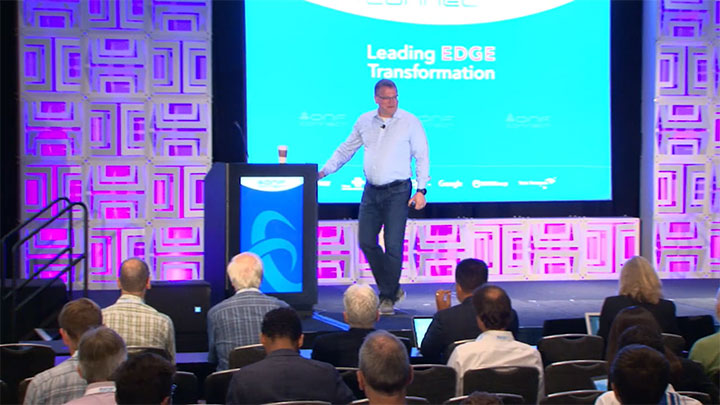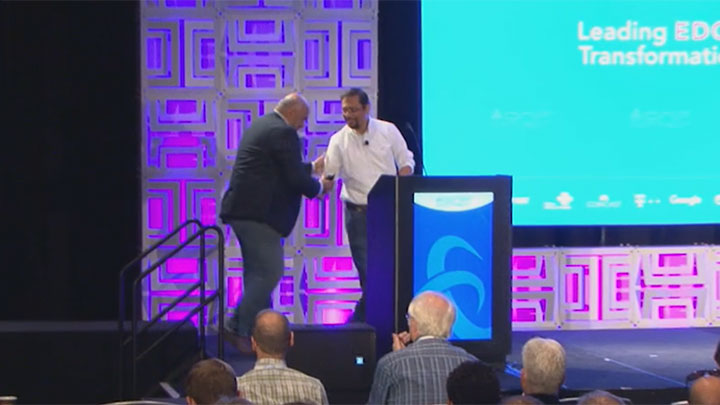Exciting
things happening with Trellis and its commercial ecosystem

In the wake of our big event, #ONFConnect 2019, a lot has been shared about the exciting possibilities and real world deployments that are taking place. In one highlight, Comcast shared that they are deploying Trellis in production for their new access and edge network.
We’ve also learned a lot about how Operators are managing to
deploy open source.
Historically, we have often heard the term
‘one-throat-to-choke’, meaning that operators want a single third-party to take
responsibility for their network deployment.
The thinking used to be that this would eliminate finger pointing,
minimize the operator’s need for engineering resources, and would result in
smooth & reliable deployments. But
what operators have learned is that such a strategy comes with significant
drawbacks, and dependence on a single vendor can quickly become a
liability. Operators lose control of
their network as they can only deploy equipment and software from this single
vendor, they become dependent on the vendor’s product roadmap, they must wait
for fixes and features to be delivered at the vendor’s discretion, and they
lose all leverage because they have become locked into a single vendor’s
offering.
Forward minded operators are addressing these business
inequities by taking control of their network, and open source has become a
critical tool in such a strategy.
Dispelling a common misperception - it is important to understand that
open source does not mean operators need to go it alone. Open source leverages disagreggation, white
box hardware and SDN/NFV/Cloud technologies to build powerful solutions, and
vendor partners can help operators as they assemble these components and
customize solutions to meet their specific needs.
New classes of vendor are stepping up to work
collaboratively with operators to help deploy open source based solutions in
ways that benefit all parties involved.
Vendors build new revenue stream by offering integration services,
custom software development or supplying hardware components. Multiple vendors may work collaboratively
with the operator in a new style of open ‘distributed DevOps’ where a virtual
teams is formed with members from all stakeholders. And software changes and enhancements are
shared in the open with the open source community in order to help build the
open source base and also to leverage expertise, enhancements and bug fixes that
come from the broader open source community.
In this model, the operator may choose to be effectively
their own prime (putting together the solution), or they may contract a prime
role to one of the vendors in the distributed team - often a system integrator. Both models can work, and the beauty is that
the operator is in control throughout either way - from defining how they want
to do business to prioritizing features, fixes and timelines. Ultimately, this gives the operator
competitive advantage and control over their future.
And this model makes financial sense too. It has been shown to substantially reduce
both capex and opex for operators (some studies have shown 25%-40% savings). And this creates new profitable revenue
streams for vendors - quite possibly at higher margins than they were seeing in
the legacy model where multi-layered supply chains relegated many players to
component or contract engineering roles.

Trellis Ecosystem
This week, a number of vendors stepped forward to declare
that they are ready to help operators who want to explore this model for
deploying ethernet-based access, edge or datacenter networks based on the
Trellis open source platform. Each of
these vendors has developed experience and/or product offerings that can help
ensure successful deployments of Trellis in production.
Example Vendors:
- Broadcom for networking
silicon and associated software drivers - Edgecore Networks for white box leaf
and spine switches - Infosys as a system
integrator
This model establishes a new formula for open source whereby an operator, ONF and a consortium of commercial entities come together to collectively build and stand behind a deployment. Ecosystem players each provide expertise according to their strengths to help make the deployment successful. Working this way enables tremendous speed and agility while giving operators the ability to manage their own destiny through open source.
This is an exciting time for the industry. Open source is not just about technology, but
about new ways of doing business.
Collaboration leads to competitive advantage, and ecosystem players that
are developing new business models now are poised to benefit as these ways of
working become the norm in our industry.
Ecosystem Commentary
“Broadcom
is pleased to work in concert with the ONF on Trellis deployments. By
supporting OF-DPA software on our DNX and XGS Silicon, we are helping to make
Trellis a robust and competitive offering, said Hasan Siraj, senior director, Core Switch Group, Broadcom. “We look forward to continuing our work with the open
networking ecosystem and driving tomorrow’s network transformation."
“Edgecore Networks is the leader in building and delivering open network platforms. Our work with Trellis for carrier access-and-edge networking and edge applications furthers our commitment to the space, and with successful production deployments now scaling, it is clear that both the technology and the ecosystem are now ready for building Trellis-based open source networks at scale,” said George Tchaparian, CEO for Edgecore Networks
“Infosys is pleased to have the
experience of supporting operators through design, trial and full operations of
Trellis-based networks. We are committed to take Trellis into new markets
backed by our global footprint and engineering expertise of delivering a
hardened and carrier grade software platform. In this rapidly changing world of
disaggregated network architecture, we see the support and customization of
open source platforms as a high-growth and an important part of our business,”
said Nitesh Bansal, SVP and Global Head
of Engineering, Infosys.
“The ecosystem has collectively
established a new ‘Distributed DevOps’ model through the process of trialing,
hardening and deploying Trellis with Comcast.
This has established a new formula for open source whereby an operator,
ONF and a consortium of commercial entities come together to collectively build
and stand behind a deployment. Working
in this manner has been shown to enable tremendous speed and agility, giving
operators significantly more control and the ability to manage their own
destiny,”said Saurav Das, VP
Engineering, for the ONF.



